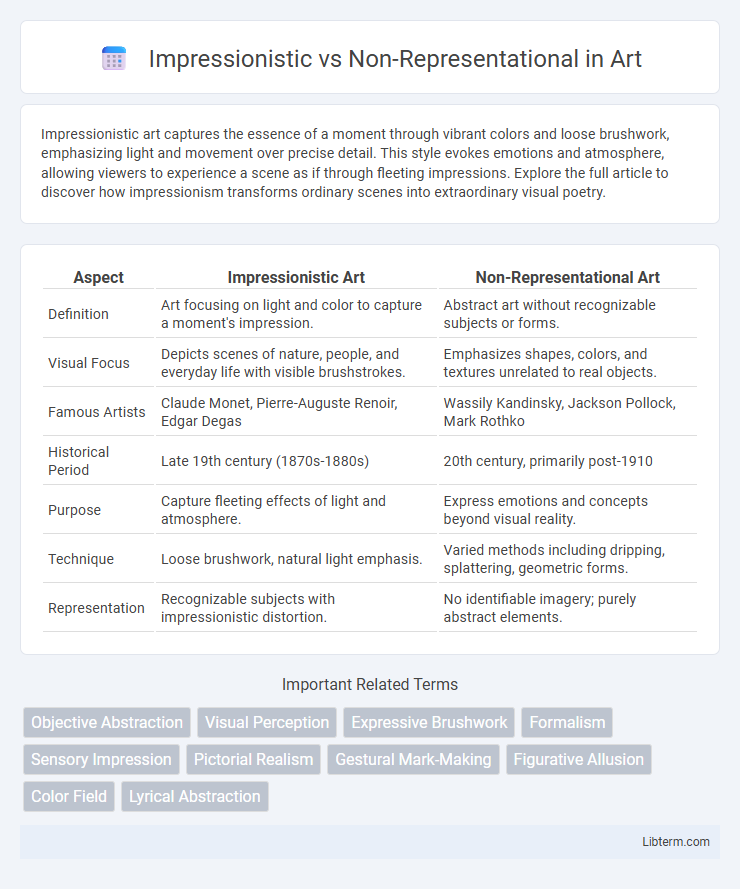Impressionistic art captures the essence of a moment through vibrant colors and loose brushwork, emphasizing light and movement over precise detail. This style evokes emotions and atmosphere, allowing viewers to experience a scene as if through fleeting impressions. Explore the full article to discover how impressionism transforms ordinary scenes into extraordinary visual poetry.
Table of Comparison
| Aspect | Impressionistic Art | Non-Representational Art |
|---|---|---|
| Definition | Art focusing on light and color to capture a moment's impression. | Abstract art without recognizable subjects or forms. |
| Visual Focus | Depicts scenes of nature, people, and everyday life with visible brushstrokes. | Emphasizes shapes, colors, and textures unrelated to real objects. |
| Famous Artists | Claude Monet, Pierre-Auguste Renoir, Edgar Degas | Wassily Kandinsky, Jackson Pollock, Mark Rothko |
| Historical Period | Late 19th century (1870s-1880s) | 20th century, primarily post-1910 |
| Purpose | Capture fleeting effects of light and atmosphere. | Express emotions and concepts beyond visual reality. |
| Technique | Loose brushwork, natural light emphasis. | Varied methods including dripping, splattering, geometric forms. |
| Representation | Recognizable subjects with impressionistic distortion. | No identifiable imagery; purely abstract elements. |
Defining Impressionism: Key Characteristics
Impressionism emphasizes capturing natural light, momentary impressions, and vibrant color using loose brushstrokes and an open composition. Key characteristics include a focus on everyday scenes, outdoor settings, and the effects of changing light on subjects. Unlike non-representational art, Impressionism retains recognizable forms while prioritizing sensory experience over realistic detail.
What is Non-Representational Art?
Non-Representational Art, also known as Abstract Art, focuses on shapes, colors, and forms rather than depicting recognizable objects or scenes. Unlike Impressionistic art, which captures light and natural impressions of reality, Non-Representational Art rejects visual references to the physical world to evoke emotions and ideas purely through visual elements. This art form emphasizes expression over representation, often using geometric patterns or spontaneous compositions to create a visual experience independent of real-world imagery.
Historical Origins: Impressionism vs Non-Representational
Impressionism originated in the late 19th century, pioneered by artists like Claude Monet who sought to capture fleeting light and natural scenes with visible brushstrokes and vibrant colors. Non-representational art, emerging in the early 20th century through figures such as Wassily Kandinsky and Piet Mondrian, abandoned recognizable subjects entirely to focus on abstract forms, shapes, and colors. The historical shift reflects Impressionism's roots in sensory experience and realism, while Non-Representational art embodies a move toward pure abstraction and emotional expression.
Techniques and Materials Used
Impressionistic art employs loose brushwork, vibrant color palettes, and techniques such as broken color and short, quick strokes to capture light and atmosphere, often using oil paints on canvas. Non-representational art, also known as abstract art, utilizes diverse materials including acrylic paints, mixed media, and unconventional tools to emphasize form, color, and texture without depicting recognizable subjects. Techniques in non-representational works often involve layering, dripping, and sculptural elements to create dynamic compositions driven by emotion and conceptual ideas.
Key Artists and Influencers
Impressionistic art, characterized by artists like Claude Monet, Pierre-Auguste Renoir, and Edgar Degas, emphasizes light, color, and brushstroke to capture moments of everyday life and natural scenes. Non-Representational art, pioneered by figures such as Wassily Kandinsky, Kazimir Malevich, and Piet Mondrian, focuses on abstract forms, shapes, and colors without representing recognizable objects. These differing approaches shaped modern art by either interpreting reality through sensory perception or exploring pure artistic expression through abstraction.
Visual Language: Color, Shape, and Form
Impressionistic art emphasizes color harmony, loose brushwork, and light effects to capture sensory impressions, using organic shapes and fluid forms that suggest reality without precise details. Non-representational art prioritizes pure visual elements like geometric shapes, contrasting colors, and abstract forms to evoke emotions and ideas independently from recognizable subjects. Both styles leverage color, shape, and form but differ in intent: Impressionism interprets reality, while non-representational art explores visual language free of direct representation.
The Role of Emotion and Perception
Impressionistic art captures fleeting moments and sensory experiences through visible brushstrokes and a focus on light, evoking emotional responses grounded in recognizable subjects. Non-representational art prioritizes pure form, color, and composition, allowing viewers to engage with the artwork on a visceral, intuitive level without referencing the physical world. The role of emotion in Impressionism is tied to perception of reality, while Non-representational art invites an internal, subjective emotional dialogue independent of external imagery.
Popular Works: Iconic Examples
Claude Monet's "Water Lilies" series exemplifies Impressionistic art, capturing fleeting light and color through loose brushstrokes. In contrast, Jackson Pollock's "No. 5, 1948" represents Non-Representational art, emphasizing abstract expression through chaotic drip painting without recognizable forms. These iconic works highlight the fundamental difference between Impressionism's depiction of reality and Non-Representational art's focus on pure abstraction.
Art Criticism and Interpretations
Impressionistic art emphasizes capturing light, atmosphere, and the sensory experience of a moment, often inviting viewers to interpret scenes through emotional and perceptual responses rather than precise details. Non-representational art, in contrast, focuses on form, color, and composition without depicting recognizable objects, challenging traditional notions of meaning and demanding interpretation through abstract visual language. Art criticism explores these differences by analyzing how Impressionism engages with fleeting reality, while non-representational art interrogates the boundaries of meaning and visual expression.
Contemporary Relevance and Influence
Impressionistic art, characterized by its focus on light, color, and everyday scenes, continues to influence contemporary artists who seek to capture transient moments with emotional depth and sensory detail. Non-representational art, emphasizing abstraction and pure form, shapes modern visual language by pushing boundaries of interpretation and encouraging subjective engagement. Both styles inform current artistic practices, driving innovation in contemporary galleries, digital media, and public art installations worldwide.
Impressionistic Infographic

 libterm.com
libterm.com